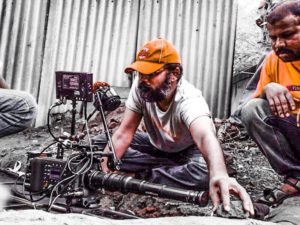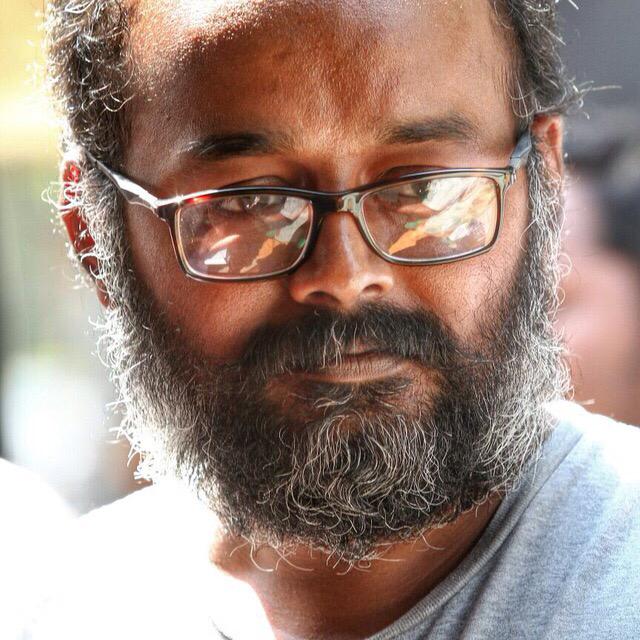
In conversation : S.R.Kathir
May 10 2020
SR Kathir is one of the most important cinematographers in the Industry to set new trends in visual language.
In conversation to SICA
1)To start with, though you have made many accomplished films in your career,we feel ‘Lens’ is definitely a standout film from its Genre & Making.
What was your thought after reading the script and share with us your preparation for it?
I liked the script because of the fact that the whole movie is going to happen in a confined 10 x 10 room space and another sequence in an apartment. The first challenging part was, we have to narrate the script through a confined space maintaining the emotional between the two characters and the audience should not feel bored. Since the story is about two characters, for the tone of the film we have kept the antagonist aravinth space in ‘Blue & white’ and for the protagonist Ananth’s space we used ‘warm & green’.Thus there will be a visual contrast in the palette and from the 2nd half of the film, their characters get upside down.This helped me to achieve and feel their contrast in their characterization.
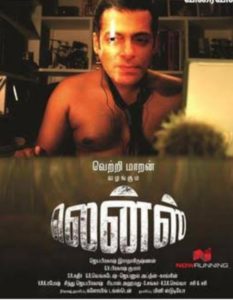
2)Also, since the story of ‘lens’ is all about spying other;s privacy through a web camera, you seemed to use broadcast-like imagery technique. Is that so ?
Yes. We usually do a green screen shoot for the TV or laptop screen, but the director Jayaprakash insisted on having a webcam kind of imagery and he felt this will make us feel more organic as if we are talking over a webcam. Also, if we shoot the sequences separately we need to go for lots of cuts and the most important thing is ‘Video Streaming quality’ is also a character in the film with natural jitters, pixelization and etc.,, which made the sequences more organic.
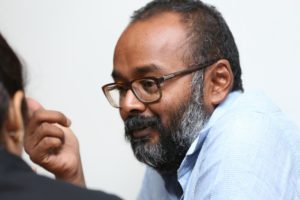
3)What about the Technicalities of the film ? Kindly share with us a few information about the camera and lights used in ‘Lens’ ?
Since the film is an experimental independent film with a limited budget and since the story is only resolving in two rooms, it didn’t require much technical support. We have shot the film in Blackmagic Camera and for the few shots of screen we have used Canon 5D Mark III to get moire free footage.
In terms of lighting,we have used household practical white lamps for the whole film and we have made the actor sit near the window to get the natural ambience.
4)It’s quite interesting. But how did you shape up & control the lights ?
We have used quite many flags and black cloths to cut the unwanted spills and since we have used all household lamps, we will switch on or off the light based on the shot. And, since the lamps were practical households & also the ambient sunlight which was constantly changing, we have colour corrected the footage during Colour Correction.
5)Nice. And you seemed to be an avid lover of Hard light & shadows, which is evident in all your films ?. When the new contemporary cinematography has gone more towards soft lighting what made you stick to this pattern even in this Digital age?
Generally, I don’t have a specific pattern of lighting and I go with the director’s vision and most importantly what script’s demands. Even I have used a lot of soft lights in Neethane En Vasantham & Enai Noki Paayum Thota song sequences & maybe the harsh side of the script demanded me to go with hard lighting in my films.
6)Have you got the inspiration for Hard Lighting & shadows from the old Hollywood ?? and one other appreciable feature is your composition which resembles European. Is that so ?
Maybe. But, i dont think it’s a conscious decision to go that way and I will go with the style which is apt for the scene and the situation of the story. Also , I like to include shadows which give dimension and depth to the face and I think punch will hold your interest.
6)And you believe that Hard lighting still holds good in Digital ?
Yes thanks to our recent Digital Cameras ARRI,RED and etc., which has enough latitude to shoot.and we have enough room to experiment. But for ‘Lens’ we have used Blackmagic which has a bit less latitude compared to others, so I need to be precise more on the Exposure & latitude and the role of DI was much needed.
7)Could you explain to us about your take on the choice of ‘Depth of Field’. Because when we believe the use of selective Depth of field to have the three dimensional feel, you do a lot of Deep focus Cinematography.
Yes I like to work on Deep Focus and I think more details to the image is much more interesting. Also, the shot length of one other criteria to consider and if the shot has long duration deep focus will definitely give more interesting elements and even if the content is bit weak.

8)We must accept the fact you are one of the few Cinematographers who have worked in diverse formats. Starting from Beta, DigiBeta, Super 16, 35mm, Super 35mm, Anamorphic and etc., And you pioneered the use of Super 16 in cult classic ‘Subramaniapuram’. What made you choose that format specifically ?
I chose Super16 mainly because of its grain structure and it added value to the retro feel of the subject. One other advantage is its wide choice of lenses. We have a lot of lenses starting from 5mm and it helped really a lot to show extreme wide shots . Even though we did the test shoot in 35mm adding the grain in the post, we felt it was not convincing. Fortunately we had a Super16mm camera available at that time and we felt the grain in this was more organic than the grain we created in DI for 35mm. Thus we settled with super16 for the film.
9)Certainly ‘Subramaniapuram’ is a landmark in the history of Tamil Cinema and the film has a very interesting iconic Climax long take shot of Kanja Karuppu walking from the riverbed to the road. Could you tell us the making of it ?
It was a 3 minute long shot and it was planned solely for the story. Because the story starts with a continuous shot of kanja karuppu walking through a long street, his radio shop and it ends it at the heroine’s house. Then the flashback portion starts and the end is at the riverbed portion. Thus we have braced the entire story with a long shot and end with the long continuous shot.
10)We must appreciate the beautiful colour space of ‘Subramaniapuram’, its rawness, its beautiful song picturizations and its timeless images. Have you planned it all after reading the script ? Could you share a few points about that ?
Yes, after reading the script I have made clear and we planned to use all colours in the first half which has fun, love and celebrations. But for the 2nd half of the film we have gone with the earthy tones in terms of costumes and for the backdrops we used a ‘Robin Blue’ for all the walls with subtle shades of gray.

11)It is interesting that you have tried the jitter to create a specific effect in some portions in ‘Lens’. Have you tried like this in any of your other films ?
Yes. I have tried in ‘Kidaari’, in which I have used the trolly movement with the same pace to have one single rhythm throughout the film.
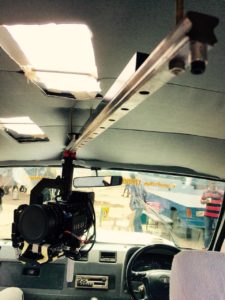
12)And in ‘Kidaari’ you have one unique shot in a van, in which we heard you shot a unique custom made Rig. Could you share about that ?
Yes. It was a custom made rig based on the principle of robotic conveyor in industries which used to carry doors and bayonets. Since we want to move the camera smoothly inside the car we have recreated the same kind of rail setup inside. We have placed the cameras along the rails with the jib head so that we get to see all the characters inside the car in all 360 degrees. We lied down between the seats and operated the camera & once the shot ends inside we loosen the camera and move out.
14)And what if we shoot the same sequence with a GoPro kind of Camera instead of a regular camera?
With GoPro i think we could get only a flat output with more wide shots and i don’t think we could get the normal lens range. Because we need a close-up and if we use GoPro we will be getting a more exaggerated look of actors and it may look a bit weird. And I feel when we use a camera which is more weight, the more stability we get, which is less possible in GoPro kind of camera.
15)You have shot many of your movies in ‘Film’ and you are shooting ‘Digital’ in all your recent films. What difference do you see in the working process and what is the advice you give to the young generations who use Digital ?
I believe shooting in motion picture film needs a lot of discipline & you have to plan and foresee many things until it ends in the lab which is bit missing in recent Digital shooting. Since we could see everything in the monitor with the help of false colours, they tend to go merely with its exposure judgement. Instead we should light meter to read the exposure, check lighting ratios, like how we did during film times which is now missing with younger generations. I urge the young cinematographers to read the light for scene to scene and I think we should maintain the exposure consistency, though we use false colours…But, the advent of Digital has made the shooting easy, like adding a custom LUT to your Live footage to check how the colours will come after the post.This gives more clarity to the costume designers and art directors and I think Digital has opened many possibilities. Finally the classical approach of film shooting should be there in Digital too and i think it will add additional value for the content we shoot.
16)Recently there is a speculation that Tamil films dubbed for international markets are not meeting the industrial standards. How do you see this ? What we must do ?
Yes. since we need to improve much in terms of maintaining the technical standards to meet the larger scale. We should take things a bit more meticulously.
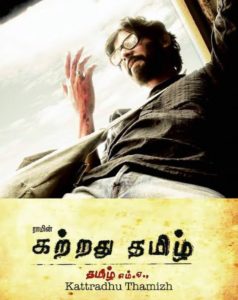
17)Coming to the very classic movie of yours ‘Kattrathu Tamizh’, it is known for its flashback portions of the hero’s childhood. That portion of the film is still fresh to see.Could you share a few things about its making?
Again it’s completely the journey demanded by the script. Being a travelogue film exploring the wide range of places the character has lived, travelled and script had a graph. The character first lives amidst a green atmosphere, moves to a place like tiruvannamalai and to chennai and finally reaches Maharashtra. Thus there is a sequence of geography we need to show & again the things needed in the story, how a boy’s young beautiful life got changed and ends with a distressful middle age.
Also, thanks to Director Ram who wrote the story in such a way and has taken the story into spaces like the boy & girl travels to mountains, caves , carrying lanterns etc.,I think all such elements in the film gave me scope to create beautiful visuals .
18)What were the timings you have shot?
Because there is a beautiful difference in lighting in boy’s portions and in grown up man’s portions.
We have shot boy’s portions mostly during mornings & evenings for the natural beauty and during the day we will move for interiors. Once the boy grew up as a man we changed the lighting pattern to harsh and there was no ‘fill’ for the characters. I have completely shot only with key lights and that’s how I differentiated the visual contrast.
19)And your film ‘Rajathandhiram’ is more of a heist genre and the visuals totally contrast in your approach and you have dealt it more like a Sci-fi film. What was the process behind it. Share us some technicalities of the film?
For Rajathandhiram i have gone more with contrast lighting suited for its genre and again it is a medium budget film. I have shot the film in different cameras starting from Alexa, old & new RED cameras, Blackmagic & even 5D cameras and I didn’t use much rigs in the film except for a sequence where I used steadicam. But it took a big time during DI since it has different formats and it was quite challenging too.
20)You also share special rapport with International Srilankan filmmaker Prasanna Vithanage. How it evolved ?
We happened to meet at the Delhi film festival during his film screening ‘Ira Madiyama (August Sun)’. I have a friend Director Mamallan with whom I have collaborated on a short film called “Naanum” and it has a similar plot with Ira Madiyama. We had an interesting discussion with him and from then we shared a special bond. Whenever he comes to chennai for his films post-production we used to meet. We often meet at Editor Sreekar Prasad’s house and had a variety of conversations on his filmmaking, world movies and I have high regards for his style of filmmaking. He is one such rare filmmaker who has done films with humanity and he never takes stands.
21)Do you have any inspirational figures you adore or you follow ?
I watch & adore many filmmakers and cinematographers, but I respect Christopher Doyle for his ranges of works. I am always surprised to see his variation of works starting from classical or to whacky. See his variety of works starting form – In the mood for love, Rabbit proof fence, fallen angels, Hero and etc., He is totally inspiring.
22)Coming to your early short film era
Tell us your approach, how is your day of shoot starts ??
I usually go with the vision of the Director what he wants and if it tallies with my mindset I will go ahead with the same.I will only intervene if there needs an improvement which makes the scene more interesting. And i usually shoot ‘axis’ wise- finish shooting the shots in one axis and will move on with the next. This will help us to keep the lighting continuity and consistency. But going with the scene order may lose this essence and I prefer to shoot the master shot first if possible. Because this will give an idea for all the screen actors what we are going to shoot in consecutive shots.
23)Since you have worked with a variety of Directors how do you work with someone who is visually strong and with someone who gives full image control over to you?
Yes it happens in both ways. For example with Director Ram he always gives me challenges and he gives me different topographies which drives you more visually. Whereas working with Gowtham Vasudev Menon and Jeyaprakash, they completely give the freedom on the choice of shots and they will inquire whenever there is a necessity for a change of shot. And with Assuravatham, director marudhu writes the visual notes while writing the script itself which makes our work easy.
But at times, with some directors who emphasize dialogues, expressions and emotions, we need to explain the type of shot. Even if they are not convinced we have to explain why we are planning like that. So it varies from director to director.
24)And since cinema being an Audio and visual medium, what is your thought about view on sound giving more power to the visuals ?
Yes I do believe sound is very much an important one and I have a habit of hearing music before my shoot. For example, while shooting for a mystery or murder i hear eerie music which gives me to go sync with the script, even designing the track shot. Thus a rhythm will create naturally and this will aid the music and even the editor to have perfect edit points.
Yes. It’s interesting. Even Filmmakers Balu mahendra and Girish Kasaravlli seemed to use this technique.
Even for the ‘vettaruva veecharuva’ song in Kidaari, we got the song before and we have really fixed the rhythm for the whole film there and it was maintained throughout the film.
25)How do you see the evolution of lights from Tungsten,HMI, PAR to the new age LED Panels ?
Yes. Definitely the new age lights have made us more convenient and it lessens the struggles we used to get at the desired effect. For example, when we use a 1.2 PAR to bounce off with a bounce-board for bounced lighting, the same effect can be achieved with panel lights in which we can control the illumination with less ease. But this setup does not help for night shoots which spills a lot. For the night shoots I still rely on the traditional Tungsten, HMI PAR and dinolights.
26)What is your favourite choice of lenses ?
I have used ultra primes most of my time and my recent addition is supreme primes which is very fast with the aperture starting from T 1.5
27)Do you have any favorite focal length ?
I always love 50mm for its details even in the background and I also use 35mm a lot. I really love the Depth of field created by these ranges and the angle of coverage close to our human eye.
28)Could you share with us a few experiences of shooting the Tamil’s first Web Series “Queen” ? Alslo, pls. do share the technical specifications given by OTT platforms.
It was quite an interesting thing to shoot for OTT platforms and they are open to creative ideas. For example in the 7th episode of Queen we shot a circular trolley mounted with a crane and the shot was about 4 minute length. They really like the idea of shot and even Director Gautham Vasudev Menon likes and encourages us to do new experiments.
One big challenge we faced in Queen was, since it was shot by two other cinematographers Velraj and Manikandan along with me, we need to maintain the image consistency in all three portions. We have applied a KODAK filter and corrected the contrast & vibrance of all three portions to get the final look.
The first thing OTT platforms recommend you to follow is the strict technical specifications cited by them. They clearly monitor the aspect ratios, formats, resolutions and the output format and the sound formats.
Article compiled by
Gowrishankar( Cinematography faculty)
Conversation scripted by: Mahesh Muthuswami and CJ.Rajkumar

